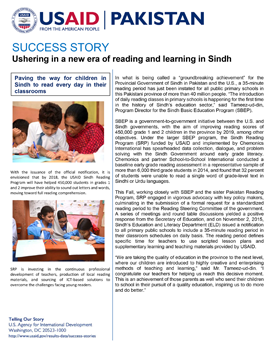Sindh, Pakistan’s second largest province, has made recent economic progress, but its education indicators are still low, with about 4 million children ages 5 to 12 not in school.

Ushering in a New Era of Reading and Learning in Sindh .
Project Success Story | December 30, 2019

The Sindh Basic Education Program was a government-to-government initiative between the U.S. and Sindh governments, with the aim of improving reading scores of 450,000 grade 1 and 2 children in the province by 2019, among other objectives.
The USAID-supported Sindh Basic Education Program (SBEP), and its partner group the Pakistan Reading Program, endeavored to increase reading scores of 450,000 children in grades 1 and 2 in the province by 2019, among other goals. One of the ways this was achieved was through an activity within the SBEP Program, the smaller Sindh Reading Program (SRP), which was implemented by Chemonics International. SRP engaged in vigorous advocacy with key policy makers, culminating in the submission of a formal request for a standardized reading period to the Reading Steering Committee of the government. A series of meetings and round table discussions yielded a positive response from the Secretary of Education, and on November 2, 2015, Sindh’s Education and Literacy Department (ELD) issued a notification to all primary public schools to include a 35-minute reading period in their classroom schedules on daily basis.
- Success Story Ushering in a New Era of Reading and Learning in Sindh
